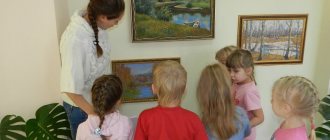TARGET SECTION
Explanatory note
Goals and objectives of the Program implementation
Determined in accordance with the Federal State Educational Standard of Educational Education, the Charter of the educational institution.
The goals of the Program are: creating conditions for the development of a child that open up opportunities for his positive socialization, his personal development, development of initiative and creativity based on cooperation with adults and peers and age-appropriate activities; creating a developmental educational environment, which is a system of conditions for socialization and individualization of children.
•Can be supplemented with the goals of correctional and developmental work
The objectives of the program implementation will be determined on the basis of clause 1.6 of the Federal State Educational Standard for preschool education:
•Can be supplemented in accordance with the goals of implementing partial educational programs and correctional and developmental programs (in accordance with the Charter)
Principles and approaches to the formation of the Program
•Formulated on the basis of Federal State Educational Standards DO clause 1.4.
•Can be supplemented by the principles and approaches of the author’s comprehensive educational program and partial educational programs, provided that they are consistent and lack duplication.
Characteristics significant for the development of the Program
The location of the preschool educational organization, the features of the building and the walking area, their influence on the organization of educational activities.
Characteristics of national and cultural characteristics and social environment that influence the organization of educational activities.
Information about groups operating in a preschool educational organization (number of functioning groups, occupancy, group orientation (general developmental, compensatory, health-improving or combined orientation), number of groups of different orientations)
Information about parents as participants in educational relations (characteristics of the well-being / disadvantage of families at the time of the creation of the program, educational requests of parents at the time of the creation of the program).
Characteristics of the developmental characteristics of children of early and preschool age (the main age-related psychological and pedagogical characteristics are indicated, their significance for the implementation of the Program)
Planned results of mastering the Program
1 design option.
Are specified in accordance with age groups based on the targets of the Federal State Educational Standard for Education.
2 design option.
They are specified in accordance with age groups based on the educational areas of the Federal State Educational Standard and taking into account the target guidelines of the Federal State Educational Standard for Education.
An example of an educational area is cognitive development.
Example. Social and communicative development (3-4 years)
- The child participates in joint activities with the teacher
- Agrees on joint activities with peers, enters into paired interactions regarding toys and play activities
- Maintains a predominant emotional and positive mood in kindergarten
- Emotionally responds to the pronounced emotional state of close adults and peers
- Uses forms of greeting, farewell, request and gratitude
- Self-care requires a little adult assistance
- Imitates the work actions of adults
- Shows in pictures ways to use objects safely and potentially dangerously.
Basic models of the educational process in kindergarten.
A model description of the educational process and pedagogical activity at the stage of preschool education was carried out by N. A. Korotkova and N. Ya. Mikhailenko. When describing the model of the educational process in kindergarten, the authors introduced the following dimensions: the functions (positions) of an adult in relation to the children's community, the organization of educational content (or developmental content), the structure of the subject environment. These dimensions create the overall educational environment into which the child is immersed kindergarten.
The identified dimensions allowed the authors to reduce all preschool programs (both modern and existing in the history of pedagogy) to three general types of models of the educational process: 1) educational model; 2) complex thematic model; 3) subject-environment model. Here is a brief description of each of the models.
The educational model is characterized by the organization of educational content on the principle of divided academic subjects (by areas of knowledge or by types of activity), each of which has its own logic of construction. This content of education is closely related to a certain position of the adult—the teacher’s: the initiative and direction of activity belongs entirely to the adult. The model is designed for rigid programming of the educational environment - its topography (in the form of a “collection” of educational subjects) and time development (deployment of educational content throughout the year in the logic of the educational subject).
The educational process unfolds in a disciplinary school-lesson form that keeps children within the framework of the academic subject. The subject environment serves the lesson, and its organization takes the form of teaching aids. The unambiguous correspondence of developmental tasks, educational subjects, subject environment and the uniqueness of the adult’s pedagogical position are ideally aimed at motivating the child’s activity adequate to the academic subject. All unplanned types of activity and initiative of children are not welcomed and are excluded by adults.
The complex thematic model uses an organization of educational content that is more organic for a preschooler: a topic as communicated knowledge about any sphere of reality, presented in an emotional-figurative rather than an abstract-logical form. Preliminary selection of main topics for adults makes the educational process systematic and culturally appropriate. At the same time, the projection of the topic onto different types of children’s activities (“living” it by the child in play, drawing, design) and the possibility of their choice by the child himself make this model less rigid and ensure the development of children’s initiative. The implementation of the topic in a complex of different types of activities, as it were, forces the adult to a freer position than the teacher’s; it can be designated as the position of a partner, employee. In this model, the organization of the subject environment also becomes more flexible, constantly adapting to the developmental tasks and initiative of children. Responding to the psychological characteristics of preschool age, the complex thematic model places very high demands on the general culture, flexibility, creativity and intuition of an adult, without which the model simply does not work.
The essence of the subject-environmental model is that the contents of education are projected directly onto the subject environment, bypassing the adult as an active bearer of these contents. The classic version of this model is entirely built on a conceptually justified artificial and strictly limited subject environment (M. Montessori system). The adult in this model is only the organizer of the subject environment, his function is the selection of developmental material that is autodidactic, itself provokes trials and records the child’s mistakes. The topography of the educational environment does not change throughout preschool age; only the child himself will change, drawing out the developmental content embedded in the subject material in the process of repeated exercises (a more modern version of this model is built on a subject environment that is close to the “natural” forms of the child’s activity).
Limiting the educational environment only to subject material and focusing on the child’s self-development in this model leads to the disappearance of the systematic nature of the educational process and sharply narrows the child’s cultural horizons. At the same time, like the educational model, this model is technological and does not require creative efforts from an adult.
In the history of preschool pedagogy, the last two models were proposed as alternatives to the formalism and rigidity of the educational model (essentially imitating the school system), which does not take into account the uniqueness of preschool age and is ineffective in the education of preschoolers.
Modern models of organizing educational activities within the framework of the Federal State Educational Standard before
Hope Taved
Modern models of organizing educational activities within the framework of the Federal State Educational Standard before
Currently, very serious changes are taking place in the preschool education system. According to the Federal Law of the Russian Federation of December 29, 2012 No. 273-FZ “On Education in the Russian Federation”
, Federal State Educational Standard for Preschool Education, preschool education is the first level of general education and key in the development of a child’s personality and the disclosure of his potential abilities. The main goal of policy in the field of preschool education is quality education for preschool children.
The educational process in our preschool institution is carried out according to the main educational program of preschool education of the MDOU "Kindergarten No. 7KV"
, developed in accordance with the requirements
of the Federal State Educational Standard for Education , taking into account the main basic regulatory documents. The main educational program is a model for organizing educational activities in a preschool educational institution , the goal of which is to create “conditions for the development of a child that open up the opportunity for his positive socialization, his personal development, the development of initiative and creativity based on cooperation with adults and peers and age-appropriate activities ” (
Federal State Educational Standards up to 2.2.4 ) .
The teaching staff of the kindergarten is actively working to create a model of the educational process, using new forms of its organization .
Each teacher of our preschool educational institution has developed a work program for children of their age group in accordance with the main educational program of the kindergarten, which ensures the diversified development of children, taking into account their age and individual characteristics in the main areas - physical, social-communicative, cognitive, speech and artistic-aesthetic development. We consider the educational process today as a systematic, purposeful process of comprehensive development, training and education of preschool children, taking into account their individual and age characteristics, carried out in various models and forms of preschool education, in accordance with the federal state educational standard. The educational process must provide each individual child with the opportunity to satisfy their developmental needs, develop their potential abilities, preserve their individuality, and the opportunity to self-actualize. The main task of kindergarten teachers is to create conditions under which the child develops, fully lives through preschool age and is motivated to move on to the next level of education.
The specificity of preschool age is such that the achievements of preschool children are determined not by the sum of specific knowledge, abilities and skills, but by a set of personal qualities, including those that ensure the child’s psychological readiness for school. It should be noted that the most significant difference between preschool education and general education is that in kindergarten there is no strict subject matter. The child's development takes place in play, not in learning activities .
The Federal for Education puts first place an individual approach to the child through play. The fact that the role of play as the leading activity of a preschooler is increasing and that it is given a dominant place is positive, since in recent years, due to social changes in society, computerization, as well as the intensive preparation of the child for school, play is leaving the world of childhood. Today our teachers are called upon to return cognitive, exploratory, creative play to childhood, in which the child learns to communicate, interact , with the help of which he learns about the world, the relationships of objects and people in this world. A game in which the child “tryes on”
assumes different roles in which his speech, memory, attention, thinking, emotions, and imagination develop.
The leading types of children's activities in a preschool institution are: gaming, communicative, motor, cognitive-research, productive, etc. Educational activities are carried out throughout the entire time the child is in the preschool organization .
The design of the educational process at the present stage is carried out by teachers in accordance with the population of students , their individual and age characteristics.
One of the main functions of managing the process of implementing the main educational program is planning educational activities . According to the Federal State Educational Standard for Preschool Education, planning educational activities in the MDOU “Kindergarten No. 7KV”
is based on a complex thematic principle. Complex thematic planning is the most effective when working with preschool children.
Taking into account the Federal State Educational Standard for Additional Education, the model for organizing the educational process includes:
- joint activities of children and adults , where directly educational activities with the main forms of organization : play, observation, experimentation, project activities , communication,
solving educational problems in the process of regime moments;
- independent activity of children , namely the developing subject-spatial environment.
Since the introduction of the Federal State Educational Standard for Education, joint activities of adults and children are distinguished by the presence of a partnership (equal)
position of an adult and a partner form
of organizing educational activities :
The main feature of the organization of educational activities by the teachers of our kindergarten is the departure from educational activities (classes, increasing the status of play as the main activity of preschool children; inclusion in the process of effective forms of work with children: ICT, project activities , gaming, problem-based learning situations within the framework of integration of educational areas.
"Class"
as a specially
organized form of educational activity in kindergarten is canceled, but this does not mean a transition to the position of “free
education ” of preschoolers.
The activity becomes interesting for children, a specific children's activity organized by the teacher , implying their activity, business interaction and communication , the accumulation by children of certain information about the world around them, the formation of certain knowledge, skills and abilities. The learning process remains. Teachers continue to “work” with children. Meanwhile, it is necessary to understand the difference between “old”
learning and
“new”
.
Organized educational activities
in the form of educational activities through the organization of children's activities
1. A child is an object of formative pedagogical influences of an adult. The adult is in charge. He guides and controls the child. 1. A child and an adult are both subjects of interaction . They are equal in importance. Each is equally valuable. Although an adult, of course, is older and more experienced.
2. The activity of an adult is higher than the activity of a child, including speech (an adult “a lot”
says) 2. The child’s activity is at least no less than the adult’s activity
3. The main activity is educational . The main result of educational activities is the solution of any educational task assigned to children by adults. The goal is the knowledge, skills and abilities of children. Children's activity is needed to achieve this goal. 3. The main activity is the so-called children's activities .
The goal is genuine activity ( activity )
children, and the development of knowledge, skills and abilities is a side effect of this activity.
4. The main model of organizing the educational process is educational. 4. The main model of organizing the educational process is the joint activity of an adult and a child
5. The main form of working with children is an activity. 5. The main forms of working with children are viewing, observing, talking, experimenting, research, collecting, reading, implementing projects, workshop, etc.
6. Mainly so-called direct teaching methods are used (with frequent use of indirect ones)
6. Mainly so-called indirect teaching methods are used
(with partial use of direct ones)
7. Motives for learning in the classroom, as a rule, are not related to children’s interest in the learning activity . "Holds"
children in the classroom have the authority of an adult.
That is why teachers often have to “decorate”
a lesson with visuals, game techniques, and characters in order to put the learning process into a form that is attractive to preschoolers.
But “the real goal of an adult is not to play at all, but to use a toy to motivate the development of subject knowledge that is unattractive to children.” 7. The motives for teaching, carried out as an organization of children's activities , are primarily related to the children's interest in these types of activities
8. All children must be present at the lesson 8. So-called free “entry”
and
the “exit”
of children, which does not at all imply the proclamation of anarchy in kindergarten. Respecting the child, his condition, mood, preferences and interests, the adult is obliged to provide him with the opportunity to choose - to participate or not to participate with other children in a joint business, but at the same time has the right to demand the same respect for the participants in this joint business.
9. The educational process is largely regulated. The main thing for an adult is to move according to a pre-planned plan or program. The teacher often relies on a prepared outline of the lesson, which contains the adult’s remarks and questions and the children’s answers 9. The educational process involves making changes (adjustments)
in plans, programs taking into account the needs and interests of children, notes can be used partially to borrow factual material (for example, interesting information about composers, writers, artists and their works, individual methods and techniques, etc., but not as a
“ready-made sample”
educational process.
According to the theory of L. S. Vygotsky and his followers, the processes of upbringing and teaching do not directly develop the child in themselves, but only when they have activity forms and have appropriate content, therefore the content of the program is implemented in acceptable forms for a preschool child: play , communicative, labor, motor, cognitive-research, musical and artistic, perception of fiction as a special type of children's activity and productive .
The development pattern of any type of activity is as follows : first it is carried out in joint activities with an adult , then in joint activities with peers and becomes an amateur activity .
The Federal State Educational Standards for Preschool Education direct teachers to “solving program educational tasks and during routine moments in accordance with the specifics of preschool education,” which is quite logical, since approximately 60% of the child’s time in the group is spent on routine moments.
In educational activities , at special moments, the tasks of forming a general culture for preschool children are solved: a culture of behavior, communication, activity , nutrition, sleep, health, life , development of their physical, intellectual, personal qualities and prerequisites for educational activities . This is daily work that is carried out throughout the entire stay of children in kindergarten, regardless of the season, event, calendar of holidays and memorable dates.
One of the main forms in the process of education and upbringing of children in kindergarten is the independent activity of children .
Scientific research indicates that under conditions of optimal upbringing and training, children can achieve a certain level of development of independence in various types of activities : play, communication, motor, cognitive-research, productive (drawing, modeling, artistic work, labor, music.
Independent activity of children is one of the main models for organizing the educational process of preschool children: this is
1) free activity of pupils in the conditions of a subject-specific developmental educational environment created by teachers, ensuring that each child chooses an activity based on his interests and allows him to interact with peers or act individually;
2) activities of pupils organized by the teacher , aimed at solving problems related to the interests of other people (the emotional well-being of other people, helping others in everyday life, etc.)
.
The scheme for the development of any type of activity in accordance with the concept of L. S. Vygodsky is as follows: first it is carried out in joint activities with adults , then in joint activities with peers and , finally, it becomes an independent activity of the child . In this case, a special role is assigned to the teacher .
A preschool child has three basic needs: the need for communication, movement, and cognition. The group environment must meet these needs.
The standard requires that the developing subject-spatial environment be content-rich, transformable, multifunctional, variable, accessible and safe.
The organization of the developing subject-spatial environment in groups of kindergarten No. 7 is built in accordance with the Federal State Educational Standard for Education .
To organize the independent activities of children in each age group of our kindergarten, a developing subject-spatial environment has been created that corresponds to the age of the children.
When creating a developmental space in group rooms, teachers took into account the leading role of play activities in the development of children . This ensures the emotional well-being of each child, the development of his positive sense of self, competence in relations to the world, to people, to himself, inclusion in various forms of cooperation, which are the main goals of preschool education and upbringing .
The subject-development environment is organized in such a way that every child has the opportunity to do what he loves. Placing equipment in sectors allows children to unite in subgroups based on common interests (construction, drawing, manual labor, theatrical and play activities ; experimentation). The interests of both boys and girls are taken into account both in work and in play. Mandatory equipment includes materials that activate cognitive activity : educational games, technical devices and toys, etc. Materials that encourage children to master literacy are widely used. When organizing the subject-developmental environment, the principle of integration of educational areas was taken into account. The subject-spatial environment in groups changes depending on the educational situation, the changing interests and capabilities of children.
There are many games, toys and equipment in the groups, ensuring children's free choice. The selection of toys, furniture and equipment for the premises was determined by maximizing the conditions for the child’s sensory development and so that he felt comfortable and experienced positive emotions. The entire organization of the educational process presupposes freedom of movement for the child throughout the group. The group layout allows for work with subgroups and individual work. There is a division between areas for noisy and quiet games.
We managed to create conditions that meet the spiritual, social, cognitive, aesthetic, communicative, and general cultural needs of children. The subject-spatial environment created in groups provides children with the opportunity to act individually or together with peers, without imposing mandatory joint activities .
The teacher can get involved in the activities of children in cases of conflict situations that require the intervention of an adult, or, if necessary, help a particular child join a peer group.
In connection with the introduction of the Federal State Educational Standard one of the priority and most effective means of teaching and raising children in organizing educational activities . Our teachers work with great passion on various interesting projects.
Any project is a product of cooperation between children, teachers and parents . It allows you to develop cognitive interest in various fields of knowledge, form communication skills and moral qualities. Participation in the project helps the child feel important, feel like a full participant in events, and helps strengthen the position of “I myself”
,
“I will do”
,
“I can”
.
Children have the opportunity to express themselves in various activities , contribute to the common cause, show individuality, and win a certain position in the group.
At the heart of any project is a problem that requires research to solve. Mandatory components of the project are children's independence (with the support of a teacher, co-creation of children and adults. Parents of our students participate in the implementation of the program, in creating conditions for the full and timely development of the child. They are active participants in all projects, and not just outside observers: they actively participate in and exhibitions of joint family creativity.Teachers hold parent meetings, consultations on various topics of interest to parents, and introduce children to their achievements.
So, all the presented forms of organizing educational activities are well known to us, teachers. And today they need to be organized in such a way that they are aimed at the child, and no matter what form and method of working with children the teacher chooses, it is very important to adhere to the position “not above the child, but with him”





